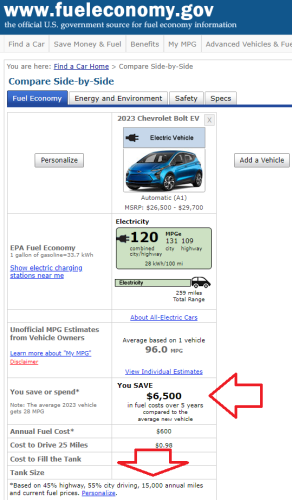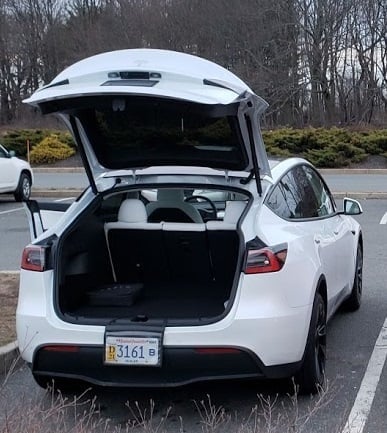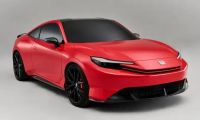Electric vehicles offer many advantages over conventionally-powered gas vehicles and also some advantages over hybrids. The opposite is also true. This story focuses on ways that the energy savings from switching to electric vehicles are often exaggerated.

EPA Energy Savings Are Based On Questionable Values - Here’s Why
The EPA is responsible for informing Americans about the cost of energy for vehicles they buy, how it compares to other similar vehicles, and the environmental impact of the emissions from the energy the vehicles use. The EPA flat-out exaggerates the “You save…Compared to the Average Vehicle” claims it makes on its website and on window stickers of cars.
The EPA has nothing but the best of intentions, and our respect for the group’s ability to predict the MPG of a gas-powered car is immense. However, with EV energy estimates, the EPA’s hands are tied in many respects. One thing the EPA had to decide when it calculated energy costs per year for vehicles is the number of miles the example vehicles cover. If you look at the fine print related to their cost of energy values, you will see that 15,000 miles per year is the distance used. The problem is, studies show that EVs don't cover anywhere near that distance per year “on average,” and in fact, neither do gas-powered vehicles.
Compared to gas-powered cars, affordable EVs average less than half the distance per year in driven miles, according to a study conducted this past month by iSeeCars. Luxury-priced EVs made by Tesla cover more miles, but 10,000 miles per year is their average, not 15,000 miles. Therefore any energy per-year savings claims made by the EPA (using its artificial 15,000-mile distance) are exaggerated significantly.
Let’s take the Chevy Bolt as an example. The EPA says that the Bolt saves $6,500 over five years by comparison to “The average new vehicle.” But why would the “Average new vehicle” have anything to do with a subcompact green car? The most popular selling vehicle in America is the Ford F-Series. What difference does it make how a work truck compares to a tiny city car? The largest vehicle segment is the CR-V and RAV4 segment. These midsize crossover SUV vehicles outsell all other types, including trucks. Why would the energy costs of a compact city vehicle compare to a mid-sized family vehicle with dramatically more passenger and cargo room? Wouldn’t it make more sense to compare the Bolt’s energy savings to the top-selling vehicle in its own segment? Perhaps the Prius?
By comparing EVs to “the average vehicle” and by artificially inflating the miles that EVs might be driven, EPA’s cost savings estimates end up being doubly exaggerated.
Winter Highway Driving Dramatically Increases EV Energy Use
Unlike gas-powered and hybrid vehicles, EVs use about twice the advertised energy per mile during winter highway travel than they do when used in suburban driving during moderate temperatures. EV advocates defend this by stating that ‘Gas powered cars use more energy in winter on the highway as well.” While true, we have been testing vehicles here at Torque News for two decades, and the gas-powered and hybrid cars do meet their EPA-estimated highway mileage in winter. There are nearly no examples where this is not the case.
We could try to create some math or cite the many studies by respected groups like AAA and Consumer Reports that show dramatic differences in EV energy consumption in winter vs. moderate temperatures, but there is no need. Visit any EV fan club on Facebook or your favorite social media platform and let the EV owners themselves convince you. EV owners discuss reductions in winter and highway ranges in great detail. Unless the club admin stops the discussion since it is so commonplace. In stop-and-go local traffic, EVs are great, just like Hybrids. Both regenerate power when braking, and both are off when not moving. However, on the highway in winter, EVs have a dramatically higher energy usage and dramatically lower ranges than promised. It’s the EV alliance’s dirty little secret. Are we supposed to pretend it’s OK?
EV Advocates Cite “Average Electricity Costs” - Are Yours Average?
Another way that EV energy costs are exaggerated is by calculating their costs using the “average cost of electricity.” We understand the intent here. However, the average electricity cost is meaningless to you as an EV owner. All that matters is what your utility provider charges. You have no choice but to use the electricity delivery company servicing your area. You can buy electricity itself on an open market, but those costs are all also local. In the end, how your local grid is supplied with electricity is all that matters. With cheap coal gone, nuclear power almost gone, and natural gas prices surging, the cost of generating electricity is only going to get more expensive.

Metro Boston is an affluent, progressive region located in the heart of a ZEV state. How much do we love our EVs? Here, the Teslas are sold at dealerships. The test cars even sport state plates stamped “Dealer.” The region was one of the very first to embrace EVs, and the area has a very good ranking on all the charts listing public charging stations per person. It also has crazy-high electricity costs from its primary supplier. Electricity often costs around $0.35/kWh.
At this electricity price point, EVs do not offer the best cost per mile for energy. Hybrids do. The gasoline in the area is presently around $3.30 per gallon. Adjusted for inflation, gas prices have been going down over time, and electricity prices are having frequent double-digit increases. There is no meaningful cost for energy advantage to driving battery-electric vehicles in this region.
There are some exceptions. Some municipalities have local municipal power suppliers. They tend to be less expensive, but you don't get to decide if you are in or out of their coverage area. The bottom line is that “average electricity prices” are entirely meaningless with EVs since almost all EV owners charge up nearly all of the time at their homes.
Off-Peak Charging Is Not Universal - Even in EV-Friendly ZEV States
EV advocates love to point out that they can charge their EVs at home at night and pay a reduced rate. That’s great if your municipality offers it. Many do not. Such as Eversource in Metro Boston.
Public Charging Costs More Than Powering a Gas-Powered Vehicle
Have you ever noticed that almost every new EV comes with “Free charging?” This is not a scam; it is real. Most EV manufacturers have partnered with public charging companies to offer a temporary period of no-cost public charging along with the purchase of a new EV. Step back and ask, “If public charging of an EV is so cheap, why do automakers have to offer it for free?”
The answer is that public charging is the most expensive way to charge an EV. Tesla Superchargers and public DC Fast Charging companies often charge as much as $0.50/kWh. At that price point, any similarly-sized, affordable, gas-powered car will have a cost per mile similar or better when compared to an EV. Hybrids are much less costly to power.
Related Story: It Costs More To Power The Lightning Than the Hybrid Ford F-150 In This State
New EV Owners Often Cite Silly Comparisons To Proclaim Their Energy Savings
One way that some EV owners love to explain their energy savings to friends and family is by comparing the cost of their old gasser vehicle to their new EV. Many skipped the entire green vehicle movement over the past two decades. They will be sure to tell you that compared to their twenty-year-old Dodge Ram, their new Leaf is almost free to drive. Well, of course it is. One is a full-sized truck, and the other is a compact car. You don’t hear a lot of former Elantra hybrid owners making such comparisons.
Solar Is Not Free
If you own your own home and plan to be in it for 30 years, solar can work out really well. Your neighbors will pay for much of it. The government takes their tax dollars and charges them surpluses on their electricity, and then funds your solar power rebates. It is a great deal, take it if you can.
We priced out solar for a home in Metro Boston this past year. Its price, not including tax deductions, was $65,000. This is for a house with an annual electricity cost of around $2,000. Maybe that will end up being a great deal for the owner if they stay in the house. However, if you move, your savings turn into huge losses. Three local realtors from popular agencies we spoke to explained that solar has no added resale value. The reason? The next owner can lease solar with no money down, assuming they plan to stay for 30 years.
Our realtors also warned us that leased solar could kill home sale deals in hot markets. Buyers fatigued from bidding wars who are over-paying with cash don’t want the hassle of negotiating a lease buy-out or transfer on an old solar system on the house they are considering. Why would they? They can get a different house and get a new solar system with no money down.
Solar is a fantastic deal for some homeowners. For many who rent or live in a condo, it is not even an option. For many who plan to move in five to ten years, it is also not a way to save money.
Your Home May Need Thousands In Updates Before You Can Charge At Home
Most EV owners charge at home most of the time. This has been true since the modern age of EVs began 13 years ago, and it is true today. In order to charge at home, you first have to have a home. If you rent or live in a multi-story building, good luck. You’re swimming against the tide.
If you do own a home, be prepared to spend thousands to update your home’s electricity service to enable the installation of a new Level 2 EV charger. There are many reasons why installing a new charger may not be possible. Perhaps your home simply doesn’t have 200-amp service, and the delivered power is already at its maximum. Perhaps the panel does not have room left and was not designed for tandem breakers. Maybe you own a large home with a 200-amp service, but adding mini-splits, a home heat pump hot water system, and a pool heater has maxed out the power, so now you need greater than 200-amp service. These are all real-world examples electrical inspectors we interviewed have shared.
Your author has replaced the panel in two homes and entirely updated the service from the pole on a third. Costs range from about $2,500 to about $6,500 to update a panel or add a higher-amperage service to a home. Maybe you will get lucky and your panel can accommodate a new 50-amp circuit for your EV charger. If so, you hit the lottery. If not, a hybrid will save you a lot of money on energy and reduce your emissions with no expensive changes to your home.
So Your Author Hates EVs, Right? Wrong.
Don't let the facts above give you the wrong impression. Your author loves EVs. I drive EVs about half the time. It is easy to say that EVs are more satisfying to drive than gas-powered cars and, in general, more enjoyable to drive than hybrids. The ample, smooth, linear torque provided by battery-electric vehicles simply kicks gas-engine dynamics to the curb.
EVs also hold the promise of a future with lower vehicle repair and maintenance costs. That isn’t true today based on many studies. Plug-in hybrids have the lowest cost. However, if EVs somehow become much lighter and use the same tires as conventional cars, the cost advantages might become a reality. Tire costs ruin the maintenance savings for EVs to a large degree, and again, we are supposed to pretend this isn't the case.
Based on our testing, EVs make ideal second cars for use around one’s local area or when driving from home to another location that has a charger waiting. EVs are clearly the future of performance in the auto industry. They simply accelerate better in real-world situations. They are not nearly as fun as lighter cars on a racetrack, but that could change if battery weight and size someday come down to about ⅓ of what it is today.
Feel free to comment below about how you pay four cents per kWh for electricity or how you get a check from the local electrical provider for the excess energy your home solar system generates. Your experience is as valid as anyone else's. Please just acknowledge that your cost for energy experience is yours alone and may not be the same for all Americans. Even ones living in EV-friendly ZEV states.
John Goreham is an experienced New England Motor Press Association member and expert vehicle tester. John completed an engineering program with a focus on electric vehicles, followed by two decades of work in high-tech, biopharma, and the automotive supply chain before becoming a news contributor. In addition to his eleven years of work at Torque News, John has published thousands of articles and reviews at American news outlets. He is known for offering unfiltered opinions on vehicle topics. You can follow John on Twitter, and TikTok @ToknCars, and view his credentials at Linkedin
Image of Dodge Hornet charging by John Goreham. Bolt fuel economy data courtesy of EPA. Image of Tesla with dealer plates by John Goreham.













Comments
I've pointed out several
Permalink
I've pointed out several times on green vehicle sites that the cost difference between owning an EV and an economical ICE isn't that much. I've also pointed out that an FCEV may cost less to operate per mile than an EV by the end of the decade if all goes as expected and the hydrogen infrastructure can support them in every state.
Thanks for your comment, Al D
Permalink
In reply to I've pointed out several by Al D (not verified)
Thanks for your comment, Al D. It's lonely out here in the land of EV facts sometimes!